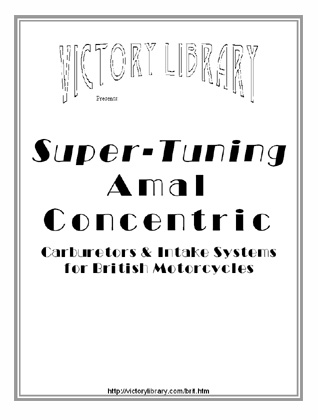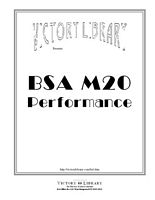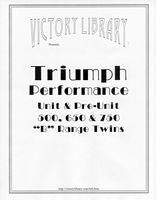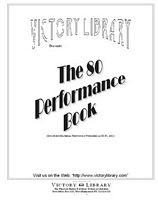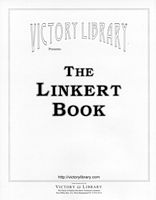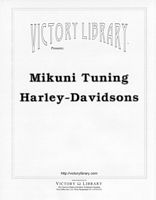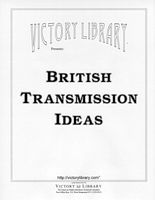 |
||||
 |
FastCounter by bCentral |
The ratio between the connecting rod
length and the stroke length of a motor greatly affects the way it performs,
and how long it lasts. This ratio (normally represented by “n”) can be
calculated as follows:
|
Effects of Long Rods
Provides longer piston dwell time at & near TDC, which maintains a longer state of compression by keeping the chamber volume small. This has obvious benefits: better combustion, higher cylinder pressure after the first few degrees of rotation past TDC, and higher temperatures within the combustion chamber. This type of rod will produce very good mid to upper RPM torque.
The longer rod will reduce friction within the engine, due to the reduced angle which will place less stress at the thrust surface of the piston during combustion. These rods work well with numerically high gear ratios and lighter vehicles.
For the same total deck height, a longer rod will use a shorter (and therefore lighter) piston, and generally have a safer maximum RPM.
Con:
They do not promote good cylinder filling (volumetric efficiency) at low to moderate engine speeds due to reduced air flow velocity. After the first few degrees beyond TDC piston speed will increase in proportion to crank rotation, but will be biased by the connecting rod length. The piston will descend at a reduced rate and gain its maximum speed at a later point in the crankshaft's rotation.
Longer rods have greater interference with the cylinder bottom & water jacket area, pan rails, pan, and camshaft - some combinations of stroke length & rod choice are not practical.
To take advantage of the energy that occurs within the movement of a column of air, it is important to select manifold and port dimensions that will promote high velocity within both the intake and exhaust passages. Long runners and reduced inside diameter air passages work well with long rods.
Camshaft selection must be carefully considered. Long duration cams will reduce the cylinder pressure dramatically during the closing period of the intake cycle.
Effects of Short Rods
Provides very good intake and exhaust velocities at low to moderate engine speeds causing the engine to produce good low end torque, mostly due to the higher vacuum at the beginning of the intake cycle. High intake velocities also create a more homogenous (uniform) air/fuel mixture within the combustion chamber. This will produce greater power output due to this effect.
The increase in piston speed away from TDC on the power stroke causes the chamber volume to increase more rapidly than in a long-rod motor - this delays the point of maximum cylinder pressure for best effect with supercharger or turbo boost and/or nitrous oxide.
Cam timing (especially intake valve closing) can be more radical than in a long-rod motor.
Con:
Causes an increase in piston speed away from TDC which, at very high RPM, will out-run the flame front, causing a decrease in total cylinder pressure (Brake Mean Effective Pressure) at the end of the combustion cycle.
Due to the reduced dwell time of the piston at TDC the piston will descend at a faster rate with a reduction in cylinder pressure and temperature as compared to a long-rod motor. This will reduce total combustion.
Harley-Davidson R, W, K & X-Series Small 4 Cam Engines | |||
Motor |
Stroke |
Rod |
“n” Ratio |
45 1932-73 |
3.8125” |
7.4375” |
1.95-1 |
K 1952-53 | |||
KR 1952-67 | |||
Sportster 1957-71 900cc; 1972-85 1000cc |
|||
XR1000 1983-84 |
6.926” |
1.82-1 | |
Evo Sportster 1986-* 883; 1100 & 1200cc, Buell 1200 | |||
KR 1968-69 Low-Boy with special short rods |
6.4375” |
1.69-1 | |
XR750 |
2.980” |
2.16-1 | |
Buell XB9 984cc |
3.125” |
7.270” |
2.33-1 |
KH 1954-56 |
4.5625” |
7.4375” |
1.63-1 |
Evo Sportster 4-5/16” stroker with S&S special # 7900 short rods |
4.3125” |
7.113” |
1.65-1 |
45 with KNS Cycle special 4-5/8” stroker & S&S # 7900 rods |
4.625” |
1.54-1 | |
45 or Sportster 1957-85 4-5/8” stroker |
7.4375” |
1.61-1 | |
Harley-Davidson V & U-Series Large 4 Cam Engines | |||
Motor |
Stroke |
Rod |
“n” Ratio |
VL 1930-36 74 In.3 (officially) |
4.000” |
7.6875” |
1.92-1 |
VLH; VHS 1935-36 80 In.3 (approximately) |
4.250” |
1.81-1 | |
U-Series std. stroke 1937-48 74 & 80 In.3; std. rods |
4.28125” |
7.90625” |
1.85-1 |
U-Series std. stroke with Carrillo rods |
8.000” |
1.87-1 | |
U-Series std. stroke with Jim's rods |
8.250” |
1.93-1 | |
U-Series std. stroke with Carrillo rods |
8.375” |
1.96-1 | |
U-Series 4½” stroker (84 In.3) |
4.500” |
7.90625” |
1.76-1 |
U-Series 4-5/8” stroker (86 In.3) |
4.625” |
1.71-1 | |
U-Series 4¾” stroker (88 In.3) |
4.750” |
1.66-1 | |
U-Series 5” stroker (92 In.3) |
5.000” |
1.58-1 | |
U-Series 4½” stroker with Carrillo rods (84 In.3) |
4.500” |
8.000” |
1.78-1 |
U-Series 4¾” stroker with Carrillo rods (88 In.3) |
4.750” |
1.68-1 | |
U-Series 5” stroker with Carrillo rods (92 In.3) |
5.000” |
1.60-1 | |
U-Series 5¼” stroker with Carrillo rods (97 In.3) |
5.250” |
1.52-1 | |
U-Series 4½” stroker with Jim's rods (84 In.3) |
4.500” |
8.250” |
1.83-1 |
U-Series 4¾” stroker with Jim's rods (88 In.3) |
4.750” |
1.74-1 | |
U-Series 5” stroker with Jim's rods (92 In.3) |
5.000” |
1.65-1 | |
U-Series 5¼” stroker with Jim's rods (97 In.3) |
5.250” |
1.57-1 | |
U-Series 4½” stroker with Carrillo rods (84 In.3) |
4.500” |
8.375” |
1.86-1 |
U-Series 4¾” stroker with Carrillo rods (88 In.3) |
4.750” |
1.76-1 | |
U-Series 5” stroker with Carrillo rods (92 In.3) |
5.000” |
1.68-1 | |
U-Series 5¼” stroker with Carrillo rods (97 In.3) |
5.250” | 1.60-1 | |
Harley-Davidson E & F-Series Single Cam Engines | |||
Motor |
Stroke |
Rod |
“n” Ratio |
E 1936-52 61 In.3 |
3.500” |
7.46875” |
2.13-1 |
F 1941-72 74 In.3 |
3.96875” |
1.88-1 | |
F 1973-80 74 In.3 |
7.4375” |
1.87-1 | |
F & Evo 80 In.3 |
4.250” |
1.75-1 | |
F 4½” stroker (84 In.3) |
4.500” |
7.4375” |
1.65-1 |
F 4-5/8” stroker (86 In.3) |
4.625” |
1.61-1 | |
F 4¾” stroker (88 In.3) |
4.750” |
1.57-1 | |
F 4½” stroker with Carrillo rods (84 In.3) |
4.500” |
8.000” |
1.78-1 |
F 4¾” stroker with Carrillo rods (88 In.3) |
4.750” |
1.68-1 | |
F 5” stroker with Carrillo rods (92 In.3) |
5.000” |
1.60-1 | |
F 5¼” stroker with Carrillo rods (97 In.3) |
5.250” |
1.52-1 | |
F 4½” stroker with Jim's rods (84 In.3) |
4.500” |
8.250” |
1.83-1 |
F 4¾” stroker with Jim's rods (88 In.3) |
4.750” |
1.74-1 | |
F 5” stroker with Jim's rods (92 In.3) |
5.000” |
1.65-1 | |
F 5¼” stroker with Jim's rods (97 In.3) |
5.250” |
1.57-1 | |
F 4½” stroker with Carrillo rods (84 In.3) |
4.500” |
8.375” |
1.86-1 |
F 4¾” stroker with Carrillo rods (88 In.3) |
4.750” |
1.76-1 | |
F 5” stroker with Carrillo rods (92 In.3) |
5.000” |
1.68-1 | |
F 5¼” stroker with Carrillo rods (97 In.3) |
5.250” |
1.60-1 | |
Indian Engines: Stroke vs. Rod Length | |||||||||||||
Motor |
Stroke |
Rod |
“n” Ratio | ||||||||||
Indian 741 |
3.0625” |
7.238” |
2.36-1 | ||||||||||
Indian 741 stroked with H-D 45 flywheels |
3.8125” |
7.4375” |
1.95-1 | ||||||||||
Indian Scout |
3.500” |
7.40625” |
2.12-1 | ||||||||||
Indian Scout stroked with H-D 45 flywheels |
3.8125” |
7.4375” |
1.95-1 | ||||||||||
Indian Scout stroked with Chief 74 flywheels |
4.4375” |
7.40625” |
1.67-1 | ||||||||||
Indian Chief 74 |
4.4375” |
8.148” |
1.84-1 | ||||||||||
Indian Chief 80 |
4.8125” |
1.69-1 | |||||||||||
Indian Chief 84 (Kiwi/Truett & Osborn flywheels) |
5.000” |
1.63-1 | |||||||||||
The angle of the rod at 90° ATDC is a good indication of how much stress the piston and cylinder wall will be subjected to with a specific rod/stroke selection (this is not the angle of maximum thrust, which occurs when the rod is at 90° to the crank, typically between 70-80° ATDC; however, the math is easy to do). Angles beyond 17° promote excessive wear at the piston major thrust surface, and piston breakage could be the result. Before you purchase connecting rods that are shorter than previous or increase the stroke of the crank, calculate the new rod angle. High rod angles will require quality rods (Carrillo, S&S, etc.) that have been checked for cracks. Piston selection will be critical for the life expectation of the engine; maximum skirt length below the pin is desired. |
Sine of Rod Angle = (2 * Stroke) ÷ (Rod Length) | ||
Rod Angle |
“n” Ratio |
Comments |
13½° |
2.142-1 |
High speed motor with small ports. Best breathing with small ports |
14 |
2.067-1 |
|
14½° |
1.997-1 |
Long rods for good breathing with small ports |
15° |
1.932-1 |
Long rods to help breathing with small ports. Responds well to stroke increases ("n" value too large for intake port size) |
15½° |
1.871-1 |
Responds well to stroke increases ("n" value too large for intake port size) |
16° |
1.814-1 |
Approximate “ideal" compromise between stress & breathing (1.81-1) |
16½° |
1.760-1 |
Good choice for motors with good breathing |
17° |
1.710-1 |
"Safe" limit for thrust angle. Approaching practical limit for street motors |
17½° |
1.663-1 |
Approaching practical limit for street motors |
18° |
1.618-1 |
Approaching practical limit for street motors. Good power due to large intake port |
18½° |
1.576-1 |
Limited street use |
19° |
1.536-1 |
Good power due to large intake port |
19½° |
1.498-1 |
Not practical for street use due to short pistons |
20° |
1.462-1 |
Poor peak power. Longer rods are used in any serious application |
See these other Victory Library booklets | |||||||||||||
"Harley-Davidson" name for reference purposes only. Not affiliated with Harley-Davidson Motor Co. | ||||||
I'm trying to locate some people I used to know; please click here for more details. Thanks! | ||||||
| Top of Page |
PANIC's Mopar Tech Papers |
Victory Library Books |
Victory Book
Order Forms |
Victory Main Menu |
Victory
Parts |
Author’s
Biography |
